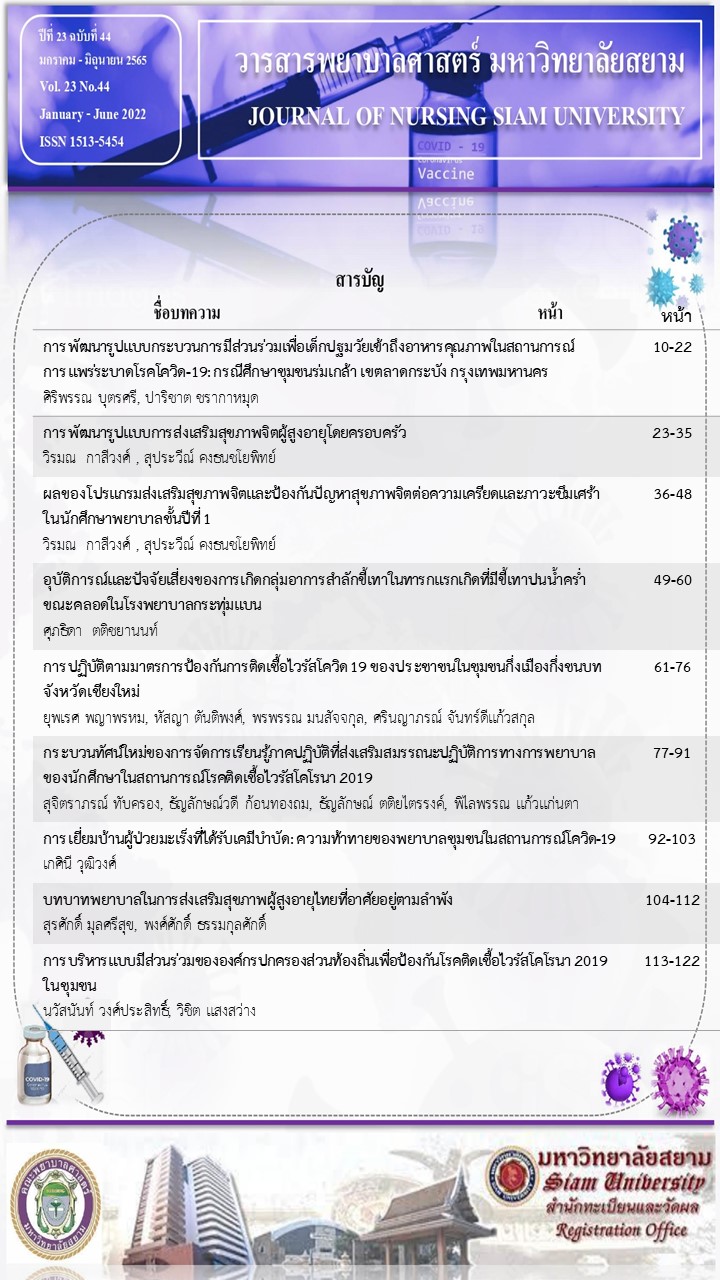อุบัติการณ์และปัจจัยเสี่ยงของการเกิดกลุ่มอาการสำลักขี้เทา ในทารกแรกเกิดที่มีขี้เทาปนน้ำคร่ำขณะคลอดในโรงพยาบาลกระทุ่มแบน
คำสำคัญ:
ภาวะขี้เทาปนในน้ำคร่ำ, กลุ่มอาการสำลักขี้เทาในทารกแรกเกิดบทคัดย่อ
กลุ่มอาการสำลักขี้เทาในทารกแรกเกิดเป็นสาเหตุเสียชีวิตที่สำคัญอย่างหนึ่งในทารกแรกเกิด โดยเกิดจากปัจจัยหลายอย่างซึ่งสามารถป้องกันหรือลดความรุนแรงได้ด้วยการหลีกเลี่ยงปัจจัยเสี่ยง การศึกษาครั้งนี้เป็นแบบ Historical cohort study เพื่อศึกษาอุบัติการณ์ ปัจจัยเสี่ยงและปัจจัยพยากรณ์โรคของการเกิดกลุ่มอาการสำลักขี้เทาในทารกแรกเกิดที่มีขี้เทาปนน้ำคร่ำขณะคลอดในโรงพยาบาลกระทุ่มแบน ศึกษาในทารกที่ถ่ายขี้เทาในน้ำคร่ำทุกรายที่คลอดและรักษาในโรงพยาบาลกระทุ่มแบน ตั้งแต่เดือนกันยายน 2562 ถึงเดือนธันวาคม 2563 พบทารกที่มีขี้เทาปนในน้ำคร่ำ 299 ราย เป็นกลุ่มอาการสำลักขี้เทา 34 ราย (ร้อยละ 11.4) เสียชีวิต 6 ราย (ร้อยละ 17.6) อาการแทรกซ้อนที่พบบ่อยได้แก่ ภาวะความดันเลือดปอดสูง ร้อยละ 20.6 ปัจจัยเสี่ยงการเกิดโรค ได้แก่ moderate meconium (OR=8.75 , 95%CI 3.38-22.62), thick meconium (OR=21.43 , 95%CI 7.41-61.99), APGAR score ที่ 1 นาที < 7 (OR=4.91 , 95%CI=1.36 - 17.77), ปัจจัยพยากรณ์โรคของทารกที่เสียชีวิต ได้แก่ ภาวะความดันเลือดปอดสูง (OR=65 , 95%CI 4.91- 861.45)
วัตถุประสงค์ : เพื่อศึกษาอุบัติการณ์ ปัจจัยเสี่ยงและปัจจัยพยากรณ์โรค MAS ในโรงพยาบาลกระทุ่มแบน
วิธีการศึกษา : การศึกษาแบบ Retrospective cohort study ในทารกที่ถ่ายขี้เทาในน้ำคร่ำก่อนคลอด (meconium-stained amniotic fluid,MSAF) ทุกรายที่คลอดและรักษาในโรงพยาบาลกระทุ่มแบน ตั้งแต่เดือนกันยายน 2562 ถึงเดือนธันวาคม 2563 ใช้เกณฑ์การวินิจฉัย MAS เมื่อทารกมีขี้เทาปนในน้ำคร่ำและมีอาการหายใจลำบากร่วมกับมีความผิดปกติของภาพถ่ายรังสีทรวงอกภายใน 48 ชั่วโมงหลังคลอด สถิติที่ใช้ได้แก่ ความถี่ ร้อยละ วิเคราะห์ปัจจัยเสี่ยงด้วย chi-square test, Fisher’s exact test และ Binary logistic regression
ผลการศึกษา : จากจำนวนทารกที่มีขี้เทาปนในน้ำคร่ำ 299 ราย พบว่าเกิด MAS 34 ราย (ร้อยละ 11.4) ทารกที่เป็น MAS เสียชีวิต 6 ราย (ร้อยละ 17.6) พบอาการแทรกซ้อนที่พบบ่อย ได้แก่ PPHN ร้อยละ 20.6 ปัจจัยเสี่ยงของ MAS ได้แก่ moderate meconium (OR=8.75 , 95%CI 3.38-22.62), thick meconium (OR=21.43 , 95%CI 7.41-61.99), APGAR score ที่ 1 นาที < 7 (OR=4.91 , 95%CI=1.36 - 17.77), ปัจจัยพยากรณ์โรค MAS ของทารกที่เสียชีวิต ได้แก่ ภาวะ PPHN (OR=65 , 95%CI 4.91- 861.45)
สรุป : พบอัตราการเกิด MAS ร้อยละ 11.4 ของทารก MSAF ปัจจัยเสี่ยงต่อ MAS ได้แก่ moderate meconium, thick meconium, APGAR score ที่ 1 นาที < 7 และปัจจัยพยากรณ์โรค MAS ของทารกที่เสียชีวิตคือ การมีภาวะ PPHN ร่วมด้วย
เอกสารอ้างอิง
จรรยา จิระประดิษฐา. (2559). การไม่แนะนำให้ดูดขี้เทาในหลอดลมโดยการใส่ท่อหลอดลมในทารกแรกเกิดที่มีภาวะขี้เทาปนในน้ำคร่ำขณะคลอดและไม่ตื่นตัวเมื่อแรกเกิดเป็นกิจวัตร:หลักฐานเชิงประจักษ์. วารสารกุมารเวชศาสตร์, 55(4),226-234.
นพวรรณ พงศ์โสภา. (2560). ภาวะความดันเลือดในปอดสูงในทารกแรกเกิด โรงพยาบาลสุราษฎร์ธานี. วารสารวิชาการเขต 11, 31(1),49-59.
ปฐมาภรณ์ ชัยธีรกิจ. (2563). ภาวะความดันเลือดสูงในทารกแรกเกิด ในโรงพยาบาลกระทุ่มแบน จังหวัดสมุทรสาคร. วารสารแพทย์เขต 4-5, 39(3),304-315
ไพโรจน์ บุญลักษณ์ศิริ. (2546). อุบัติการณ์และปัจจัยเสี่ยงการเกิดกลุ่มอาการสำลักขี้เทาในทารกแรกเกิดที่โรงพยาบาลหาดใหญ่. สงขลานครินทร์เวชสาร, 21(3),179-186
มนเฑียร นรเศรษฐ์สิงห์. (2544). ปัจจัยเสี่ยงและสาเหตุของการเสียชีวิตของทารกที่มีภาวะสูดสำลักขี้เทาเข้าปอด ในโรงพยาบาลสุรินทร์. วารสารการแพทย์โรงพยาบาลศรีสะเกษ สุรินทร์ บุรีรัมย์, 24(1),279-290.
มิรา โครานา. (2545). กลุ่มอาการสูดสำลักขี้เทา. ใน สรายุทธ สุพรรณชาติ (บก.), Update Neonatal care (62-73). กรุงเทพฯ: ธนาเพรส แอน กราฟฟิค จำกัด.
มิรา โครานา. (2551). กลุ่มอาการสูดสำลักขี้เทา (Meconium aspiration syndrome). ใน วราภรณ์ แสงทวีสิน, วิบูลย์ กาญจนพัฒนกุล, สุนทร ฮ้อเผ่าพันธุ์ (บก.), ปัญหาทารกแรกเกิด (121-132). กรุงเทพฯ: บริษัทธนาเพรส จำกัด.
อุไรวรรณ โชติเกียรติ, มิรา โครานา, วิบูลย์ กาณจนพัฒนกุล, และคณะ. (2546). ผลการรักษาความดันเลือดในปอดสูงในเด็กทารก(PPHN)ด้วยเครื่องช่วยหายใจความถี่สูง(HFOV): ประสบการณ์ 5 ปี. วารสารกุมารเวชศาสตร์, 42,1-8.
Altshuler G, Hyde S.(1989). Meconium-inducedAltshuler G, Hyde S.(1989). Meconium-induced vasocontraction: a potential cause of cerebral and other fetal hypoperfusion and of poor pregnancy outcome. J Child Neurol, 4,137-42.
Chiara M, Francesco C,Paolo EV, Giuseppe P, Benedetta A, DanialeT. (2021). Meconium aspiration syndrome: A narrative review. Children, 8,230.
Choi W, Jeong H, Choi SJ, et al. (2015). Risk factors differentiating mild/moderate from severe meconium aspiration syndrome in meconium-stained neonates. Obstet Gynecol Sci, 58(1),24-31.
Claudia PL, Filipa F, et al. (2017). meconium aspiration syndrome: risk factor and predictor of severity. The journal of maternal-fetal&Neonatal medicine,1-7.
Fischer CP, Rybakowski C, Ferdynus C, Sagot P, Gouyon JB. (2012). A Population-Based Study of Meconium Aspiration Syndrome in Neonates Born between 37 and 43 Weeks of Gestation. Int J Pediatr, 2012,321545.
Greenough A, Milner AD. (2005). Meconium aspiration syndrome. In Rennie JM (ed.), Textbook of Neonatology 4th ed (502-508). Edinburgh: Churchill Livingstone.
Klingner MC. (1999). Meconium aspiration syndrome: pathophysiology and prevention. J Am Board Fam Pract, 12,450-466.
Lindenskov PH, Castellheim A, Saugstad OD. (2015). Meconium aspiration syndrome: possible pathophysiological mechanism and future potential therapies. Neonatology, 107(3),225-230
Nangia S, Chandrasekharan P, Lakshminrusimha S, Rawat M. (2018). Approach to Infants Born Through Meconium Stained Amniotic Fluid: Evolution Based on Evidence? Am J Perinatol, 35,815–822.
Nangia S, Sundera S, Biswasb R, Saili A. (2016). Endotracheal suction in term non vigorous meconium stained neonate. A pilot study. Resuscitation, 105,79–84.
Siriporn T, Teera S. (2016). Factors associated with meconium aspiration syndrome in cases with meconium-stained amniotic fluid. Thai J Obstet Gynaecol, 24(4),240-246.
Surekha T.(2012). The significance of meconium stained amniotic fluid-A cross sectional study in a rural setup. IJBAR, 12,861-6.
Wiswell TE, Tuggle JM, Turner BS. (1990). Meconium aspiration syndrome: Have we made a difference. Pediatrics, 85(5),715–721.
ดาวน์โหลด
เผยแพร่แล้ว
รูปแบบการอ้างอิง
ฉบับ
ประเภทบทความ
สัญญาอนุญาต
ลิขสิทธิ์ (c) 2022 วารสารพยาบาลศาสตร์ มหาวิทยาลัยสยาม

อนุญาตภายใต้เงื่อนไข Creative Commons Attribution-NonCommercial-NoDerivatives 4.0 International License.
เนื้อหาและข้อมูลที่เผยแพร่ในวารสารพยาบาลศาสตร์ มหาวิทยาลัยสยามถือเป็นข้อคิดเห็นและความรับผิดชอบของผู้นิพนธ์บทความโดยตรง
บทความ เนื้อหา ข้อมูล รูปภาพ ฯลฯ ที่ได้รับการเผยแพร่ในวารสารพยาบาลศาสตร์ มหาวิทยาลัยสยาม ถือเป็นลิขสิทธิ์ของวารสารพยาบาลศาสตร์ มหาวิทยาลัยสยาม หากบุคคลหรือหน่วยงานใดต้องการนำทั้งหมดหรือส่วนหนึ่งส่วนใดไปเผยแพร่หรือเพื่อกระทำการใด ๆ จะต้องอ้างอิงวารสารพยาบาลศาสตร์ มหาวิทยาลัยสยามทุกครั้ง



